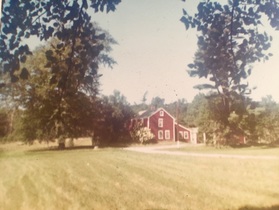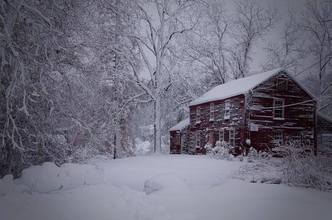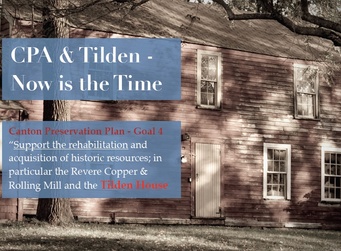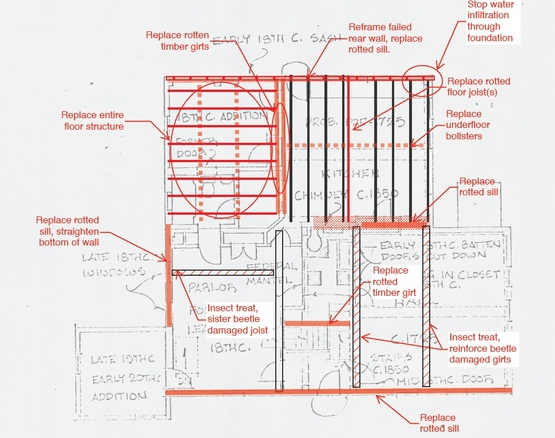 Tilden House in 1966 Tilden House in 1966 After so many years of work and dedication to this project, a flood of emotions wash over the group as we gather for the first project meeting. The kick-off meeting was held, coincidently, in the same place where more than ten years ago a group of citizens gathered to help "Save the Tilden." Not quite journey's end, but instead a new chapter and promised life for the Tilden House. There was a night so many years ago, where Patricia Johnson, Wally Gibbs, and George Comeau gathered with other concerned citizens and took up the task of working to preserve this old house. And, now after more than thirty seasons have passed over the roof, after more than 3000 days in the life of this house, the threat is being peeled back slowly. On September 24th a new group gathered. This time the excitement was secure. One of New England's foremost and experienced preservation architects sat at a small table at the home of what was once Eugene Williams and signed the contract to begin her work at the Tilden. Lynne Spencer, with years of experience and a deep knowledge of First Period buildings, sat confidently at the table. George Comeau had brought a large archival box containing the research and historical documents that had been amassed since 1970. Preservation efforts began in the early 70's when the town purchased the Draper Estate for conservation land. Since that time, the Tilden underwent fits and starts of activity. Three times it sat on the edge of serious demolition, and three times it was brought back from the brink. Today, looking at the house, it still seems to cry out "please save me," but it is so tired and so neglected that it's pulse beats weaker with each passing equinox. The task that falls to Spencer is to create a Historic Structures Report that helps us understand and guide the work that will begin in 2016. Spencer explains that what the town is about to receive is "over 100 pages of historical, architectural, cultural, and engineering data that is the basis for the demolition and construction documents to follow. The timeline is complex, but as of this writing we expect major study to be underway immediately, followed by bid documents and scoping in late winter, bidding in the spring, and construction to commence in July 2016. Once work starts on the structure, it is expected to take three-four months to complete. Yet, this is merely the start. Plenty of hard work is needed to write grants that will guide the interior restoration. New systems for hvac, electrical, and safety will need to be designed and put out to bid. This is a long term project that brings a major historical asset into the lives of the citizens of Canton. The excitement felt through the next few years will resonate across the community. In 1973, Doris Peters wrote her famed poem "Goodbye Little Red House" and in it she opined "But here it seems I'm doomed to perish. ….Wilt no man in my favour speak? If only Master Tilden wouldst, ….Come back and set me straight!" The spirits of David and Abigail Tilden are strong and it is often said that this is a building that cry's out to be saved. We are happy to report that the saving has begun, and the long line of men and women that have so ardently worked for forty years we be proud to see what comes next.
0 Comments
 After a detailed RFQ process, the Town of Canton through the Building Renovations Committee has selected the architectural preservation firm of Spencer & Vogt for design services and the production of an Historic Structures Report. There was a splendid field of professionals to choose from, but Spencer & Vogt rose to the top owing to their experience, sensitive assessments and restoration of wood frame First Period homes, and a long history or working with municipalities and museums. It is an exciting time at the Tilden House, a time of discovery, planning, and moving forward in what will be a centerpiece in preservation in Canton. Lynne Spencer noted that "the historic David Tilden House is a rare First Period structure and reminder of the town's agrarian past." These are important observations from an expert that has worked on some of New England's most treasured landmarks, including the Old North Church in Boston, H.H. Richardson's "Stonehurst" in Waltham, and Oakes Ames Hall in North Easton, the Buckman Tavern in Lexington and Longfellow's Wayside Inn. Most impressively was the firm's work at the Abigail Adams Birthplace in Weymouth. Working with such an amazing firm will mean that the Tilden House will benefit from the experience and wisdom of a firm that has specific strengths in ancient wooden structures. And, the firm has worked with over 45 Massachusetts cities and towns - key to understanding the public bidding process and the building code as it intersects with historic properties. Joining Spencer & Vogt on this project is our old friends from Structures North Consulting Engineers, the same firm that managed the engineering assessment to prepare for the Community Preservation Act Grant Application. Also, American Tower & Steeple have partnered to continue their work on estimating the project costs. Finally, the firm of Finch & Rose has joined the project as consultants on the historic framing and fabric for the preservation work. All in all, there is in place an amazing team that will work closely with the Town's Building Renovation Committee joined in the process by the Canton Historical Society, the Canton Historical Commission, the Canton Conservation Commission, the Board of Selectmen, and of course - the Friends of the Little Red House, Inc. As the project ramps up, expect to see more profiles and interviews with the experts, multimedia, and behind the scenes photos of this landmark project.  The Tilden survived the harshest winters on record. The Tilden survived the harshest winters on record. As the process moves forward, the partners in the project begin to assemble. Early on the success of this project has always been rooted in superb historical and technical research. And, as we begin the process of actually preserving the Tilden House, we start at the drawing board. A historic structures report is the foundation for all high quality preservation projects and soon, the Town of Canton will release a "Request for Proposals" (RFP) that will seek qualified preservation firms to propose their services for the Tilden. This early planning will pay off when the actual preservation begins. Deciding what will be demolished, what needs to be replaced, and the methods for which new materials are used is all part of the specifications and details for the work at hand. This critical phase lays the groundwork for developing plans and specifications that will become the documents upon which preservation carpentry firms will bid in order to do the work needed for Phase One. Working closely and in partnership with the Building Renovation Commission, we will have superb guidance, support, and oversight - to ensure that taxpayer funded preservation is done to the highest standards and meets the public procurement process. After one of the worst winters on record in New England, the Tilden House withstood tremendous roof loads as well as blizzard conditions on more than one occasion. Yet, the house bravely stood, which suggested to many of us that indeed it wanted to be saved for the next (and future) generations. As we enter this exciting new time in the life of this house, we welcome your thoughts and comments on this work.  On Monday, May 18th the voters of Canton overwhelmingly voted to support Phase One of the Tilden House preservation project. More than forty years in the making, the support came only as a result of an almost five year effort to place the Community Preservation Act within the Town of Canton. Key to passing the CPA was the Tilden House project, and at Town Meeting voters made good on their promise to preserve one of Canton's oldest houses. The Friends of the Little Red House, Inc. have been advocating for this historic site since they were founded in the early 1970s. Today, we stand on the brink of making good on the promise of preserving our legacy of not only our town but of the country as a whole. Within the next few months we expect to begin work on this amazing project. Watch this site for more information and project progress reports. Thank to the people of Canton, we will restore an amazing part of our culture, heritage, and history.  Patricia Johnson, the treasurer of the Friends of the Little Red House group stood in front of the Canton Community Preservation Committee (CCPC) making the case for the project that would "once and for all" save the Tilden House from the imminent threat of destruction by neglect. Johnson's voice trembled as she explained that "this is the last chance" for Canton to save one of the most important parts of a more than 300 year legacy. While the numbers were large, the task at hand was equally large - to convince the CCPC that the project was well planned, and indeed, would be a success. For more than forty years the Friends have been advocating for the Tilden House. When the Community Preservation Act passed, the Tilden was a cause célèbre - a poster child - for all the promises of what the CPA would do. The idea of funding historic projects that culturally are a link to our past is embedded in the CPA and the Tilden House epitomizes all that CPA stands for. In the August 2014, the Friends began work on an ambitious funding request that would use Community Preservation Act money to preserve the Tilden House. On a frigid December night, in the Community Room of the Canton Public Library, Johnson, - along with Wally Gibbs made their pitch. The questions for Johnson were tough and yet at each turn she had the answers. The timeline, the budget, the historic relevance. At least one of the CCPC members had visited the site before the meeting and exclaimed that he house is in dire condition, yet had to be saved. The presentation images flashed on the screen, and one by one each member of the committee came to see that the plan was doable and one that deserved support. The request was aimed squarely at Phase One - which would largely take care of the exterior, framing, foundation, roof, and structural interior support. Johnson explained that in fact there would be additional phases over time, but this first critical phase would mean that the house would be placed into a condition that more than renewed its lease on life. As Johnson finished, Emily Prigot - a Canton resident and National Park Ranger, spoke passionately about why we save such buildings. “This house is a powerful reminder of our origins and destiny, of our town, of our Commonwealth, and indeed, of our nation." Powerful words that resonated through the presentation. It worked, the hard work and exacting grant application paid off. The CCPC voted to recommend to the Annual Town Meeting a sum of $414,150 for a major preservation effort in the life of the almost 300 year-old home. What's next? - Work begins anew on the public relations campaign that will assure passage of the funding in May 2015. If all goes well, the plan is to begin construction in late summer 2015. Working with the Town of Canton's building renovations committee, the project has one more hurdle after Town Meeting - that being the selection of an architect to create the bid documents and specifications. It is indeed an exciting time for the Friends of the Little Red House as we get one step closer to the kicking off one of the largest preservation projects in the history of Canton.  John Wathne of Structures North, tests the density of the wood frame structure. John Wathne of Structures North, tests the density of the wood frame structure. The grant application took over seven months to conceive and draft. The decision to develop a phased approach came from the fact that this is, in fact, a very ambitious project. The process of developing an accurate projection for the funding meant reaching out to experts in engineering, preservation carpentry, and historians. The result is an accurate budget that will allow for the achievement of several key goals. In an effort to be transparent about the development of the budget for the CPA - here is how we devised the process. Since 1975, architectural historians have studied the David Tilden House. The earliest report, and still valuable today, was completed by the Society for the Preservation of New England Antiquities (SPNEA). This report by Frederick Detwiller, a noted architect and preeminent preservation planner, has been the guiding analysis of the architectural history, progression of construction, recommendations (at the time) and program development. In order to arrive at a project cost for the restoration and preservation of the Tilden House, the Friends of the Little Red House, Inc. (FOLRH), began an extensive study in August 2013. For the past several years the FOLRH have worked closely with Steven O’Shaughnessy, the Department Chairman of the North Bennet Street School Preservation Carpentry Program, to create a roadmap for short, mid, and long-term preservation. Securing and protecting this 300 year-old artifact has taken the work of some of the regions finest preservation carpenters. In fact, in the fall of 2013 (in advance of this grant request,) students in preservation carpentry produced measured drawings of the Tilden House. These plans have been extremely helpful in guiding the current phase of analysis. The Tilden House is a “living classroom” and example of early wood-frame timber construction techniques. The first major step towards completing this grant was through the engagement of the services of Structures North, Inc. – a consulting engineering firm. Structures North is one of the New England Region’s preeminent engineering consulting firms in the field of historic preservation. A structural survey was conducted in late September with a scope that included:
Following receipt of the conditions report extensive consultation with historic preservation experts led to a two-part phasing of the overall project. In order to leverage time and CPA resources, the project was phased in such a way as to work across a five-year plan. The plan that has been developed is funded in two separate CPA grant rounds.
At a meeting in early November 2014, the structural survey report was used to develop a relative order of work and a rough project plan for cost analysis. At that time some decisions were made to create a preservation time period that would bring the building’s preservation plan to a date in the mid-to-late 18th century. Fixing a period in time for the building that would allow for adaptive reuse for meeting space as well as ample space for interpretation and educational use. The next step towards “costing” this project was retaining the preservation carpentry firm of American Steeple & Tower, a highly regarded preservation carpentry company that since 1969 has had extensive experience with timber frame buildings. After a lengthy site visit and field measurements, the Building Program Costs were developed. On advice of preservation experts and other organizations that have undertaken similar and ambitions projects, a 20% contingency was added to the bottom line to manage unforeseen conditions that can only be observed once the building project is well underway. Finally, in order to understand costs associated with the proposed Historic Structures Report and associated specifications for the bid process, Groundroot Preservation Group was brought in. The work of Groundroot was completed after a site visit to both develop scope for specifications and review the budget assumptions associated with the work of American Steeple & Tower. The FOLRH are comfortable with this proposed preservation plan and know that this is an extremely complex and ambitious project that will preserve one of Canton’s first homes. |
Preservation BlogThe behind the scenes look at the preservation of this historic structure. Archives
July 2022
Categories |

 RSS Feed
RSS Feed